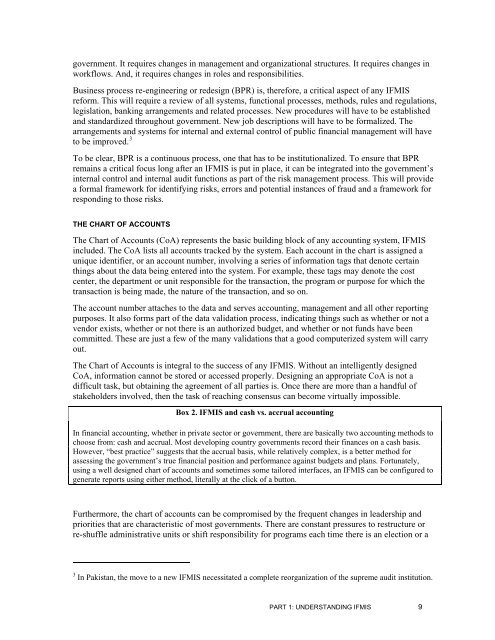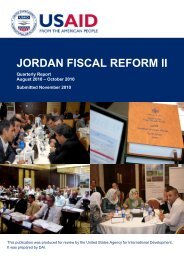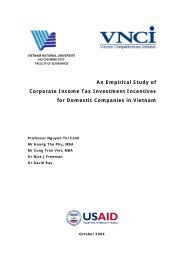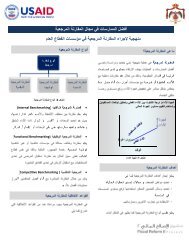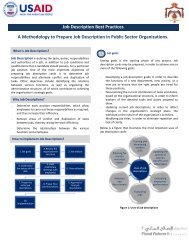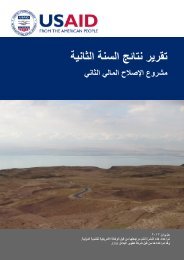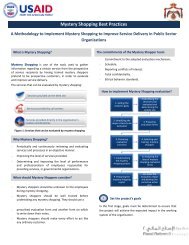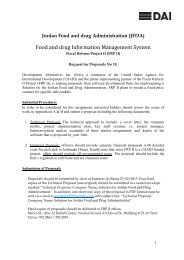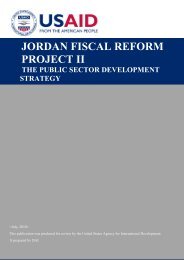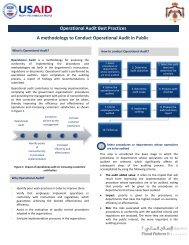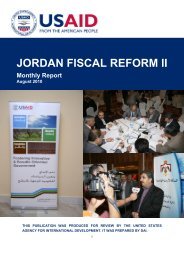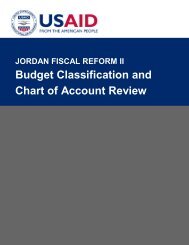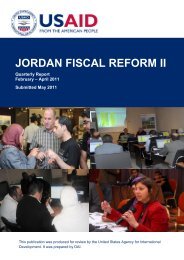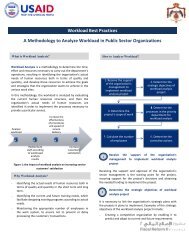Integrated Financial Management Information Systems: A ... - Frp2.org
Integrated Financial Management Information Systems: A ... - Frp2.org
Integrated Financial Management Information Systems: A ... - Frp2.org
Create successful ePaper yourself
Turn your PDF publications into a flip-book with our unique Google optimized e-Paper software.
government. It requires changes in management and organizational structures. It requires changes in<br />
workflows. And, it requires changes in roles and responsibilities.<br />
Business process re-engineering or redesign (BPR) is, therefore, a critical aspect of any IFMIS<br />
reform. This will require a review of all systems, functional processes, methods, rules and regulations,<br />
legislation, banking arrangements and related processes. New procedures will have to be established<br />
and standardized throughout government. New job descriptions will have to be formalized. The<br />
arrangements and systems for internal and external control of public financial management will have<br />
to be improved. 3<br />
To be clear, BPR is a continuous process, one that has to be institutionalized. To ensure that BPR<br />
remains a critical focus long after an IFMIS is put in place, it can be integrated into the government’s<br />
internal control and internal audit functions as part of the risk management process. This will provide<br />
a formal framework for identifying risks, errors and potential instances of fraud and a framework for<br />
responding to those risks.<br />
THE CHART OF ACCOUNTS<br />
The Chart of Accounts (CoA) represents the basic building block of any accounting system, IFMIS<br />
included. The CoA lists all accounts tracked by the system. Each account in the chart is assigned a<br />
unique identifier, or an account number, involving a series of information tags that denote certain<br />
things about the data being entered into the system. For example, these tags may denote the cost<br />
center, the department or unit responsible for the transaction, the program or purpose for which the<br />
transaction is being made, the nature of the transaction, and so on.<br />
The account number attaches to the data and serves accounting, management and all other reporting<br />
purposes. It also forms part of the data validation process, indicating things such as whether or not a<br />
vendor exists, whether or not there is an authorized budget, and whether or not funds have been<br />
committed. These are just a few of the many validations that a good computerized system will carry<br />
out.<br />
The Chart of Accounts is integral to the success of any IFMIS. Without an intelligently designed<br />
CoA, information cannot be stored or accessed properly. Designing an appropriate CoA is not a<br />
difficult task, but obtaining the agreement of all parties is. Once there are more than a handful of<br />
stakeholders involved, then the task of reaching consensus can become virtually impossible.<br />
Box 2. IFMIS and cash vs. accrual accounting<br />
In financial accounting, whether in private sector or government, there are basically two accounting methods to<br />
choose from: cash and accrual. Most developing country governments record their finances on a cash basis.<br />
However, “best practice” suggests that the accrual basis, while relatively complex, is a better method for<br />
assessing the government’s true financial position and performance against budgets and plans. Fortunately,<br />
using a well designed chart of accounts and sometimes some tailored interfaces, an IFMIS can be configured to<br />
generate reports using either method, literally at the click of a button.<br />
Furthermore, the chart of accounts can be compromised by the frequent changes in leadership and<br />
priorities that are characteristic of most governments. There are constant pressures to restructure or<br />
re-shuffle administrative units or shift responsibility for programs each time there is an election or a<br />
3 In Pakistan, the move to a new IFMIS necessitated a complete reorganization of the supreme audit institution.<br />
PART 1: UNDERSTANDING IFMIS 9


